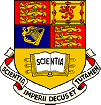
 |
|
News Page |

October 1999 |
This month's news stories:Cluster Workshop at ICCassini Earth Flyby First TAFTS Flight |
Scientists prepare for the launch of the Cluster missionOver 140 scientists from the UK, Europe and the United States attended the Cluster Workshop on Multipoint and Multiscale Plasma Measurements in the Magnetosphere, held at Imperial College on 22-24 September. The objective of the Workshop was to take stock of progress in magnetospheric physics in the past few years in preparation for the launch, next summer, of the four-spacecraft Cluster mission of the European Space Agency. This mission, the first to explore the three-dimensional aspects of small scale phenomena in near-Earth space, is expected to bring a new understanding of how the Earth's magnetic protective bubble, the magnetosphere, is affected by the large scale storms from the Sun which can disrupt the operation of communication and direct broadcast satellites. The programme of the Workshop provided a comprehensive view of hot topics in magnetospheric physics and how scientists are preparing for interpreting the expected observations from Cluster. The many scientists involved in this mission have now firmly put behind them the memory of the disaster that destroyed the first four Cluster spacecraft in 1996 and are looking forward to the Milleneum Bonanza in space physics that the rebuilt Cluster mission will bring next year. The upper photograph shows a part of the happy audience on the last morning of the Workshop. Space science is fun ! The lower photograph shows the three British Principal Investigators on Cluster with Dr. Ian Corbett (left), Director of Science at the UK's Particle Physics and Astronomy Research Council (the agency sponsoring the UK-built instruments), in front of ESA's display at the Press event held in parallel with the Workshop. The three Principal Investigators are (from the right) Dr. Andrew Fazakerly, MSSL, Dr. Hugo Alleyne, Sheffield University and Prof. André Balogh, Imperial College. Why not visit our recently revamped Cluster 2 web pages ? André Balogh 4th October 1999 |
 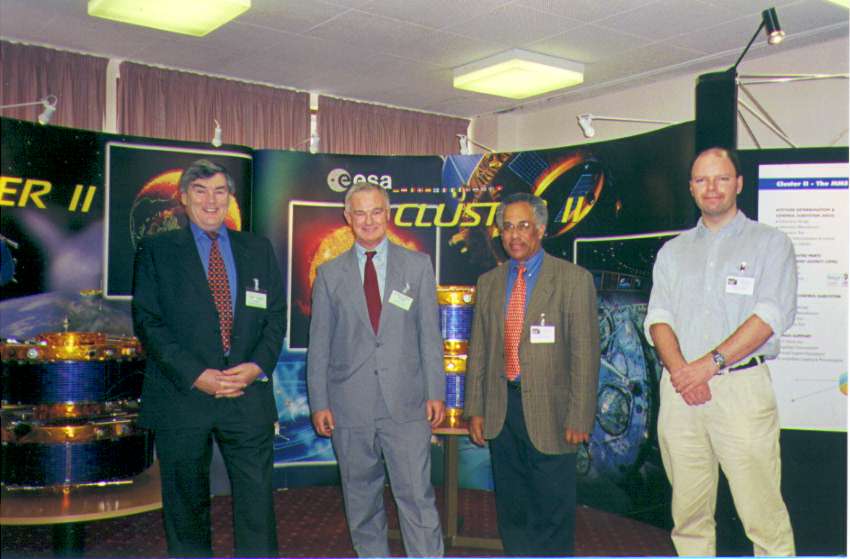 |
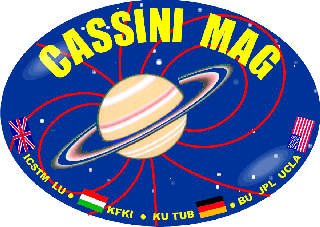 Cassini Boom Deployment and Earth Flyby
Cassini Boom Deployment and Earth FlybyThe last few months have been an exciting time for the Cassini MAG team. In June Cassini passed close to Venus to obtain a gravity assist for its journey to Saturn. Whilst the spacecraft was near the planet a number of instruments, including MAG, were operated and we obtained magnetic field data on the interaction of Venus with the solar wind. These data will be particularly useful to our Cassini colleagues with other fields and particle instruments - helping them in the interpretation of their own data.
In August the magnetometer boom was deployed placing the two MAG sensors respectively 5.5m and 11m away from the spacecraft. The boom had been retracted for thermal reasons since launch in October '97 and now for the first time we could observe the local magnetic field relatively undisturbed by the magnetic field created by the spacecraft itself. The boom (and the MAG sensors which are attached to it) rotates as it deploys thus the magnetic field observed by the sensors during deployment appears to rotate (as well as reduce in strength as the distance from the spacecraft increases). Short animations of the deployment have been made using the detected field of the sensors, these can be viewed by clicking on the following links:
Boom deployment movies by Justin Ashmall: FGM and VHM.
A few days after boom deployment, Cassini made its second planetary flyby within a few months - as before to gain a gravity assist for its trajectory. This time the planet was the Earth and many instruments, including MAG, were switched on both for calibration in the relatively well known Earth's environment but also to make new scientific observations. Our main calibration goal was to cross-calibrate our Scalar Helium magnetometer (SHM) with our Fluxgate Magnetometer (FGM), a technique that will be used during Saturn flybys. This was the only time that the spacecraft would be in a magnetic field strong enough to operate the SHM properly before arrival at Saturn. Both sensors worked beautifully and initial results show excellent agreement between them. Our main science goals were to make detailed, and high time-resolution, measurements of the Earth's magnetosphere, particularly in the tail and boundary regions. Cassini's high speed took it through the magnetosphere in about 7 hours, providing us with a unique snapshot of the environment. We were fortunate to find that both solar wind and magnetosphere were in highly disturbed states making our measurements even more valuable.
Plot of Magnetic field magnitude during Earth flyby.
The plot shows the magnitude of the magnetic field measured by the FGM during the closest approach period. To complement these measurements, our Leicester University Co-Is had arranged for simultaneous observations to be made by a whole variety of ground-based and Earth orbiting instruments - ACE, WIND, IMP8, Interball, Fast, Geotail, Polar, Samnnet, Greenland and Canadian magnetometers, Oersted, Canopus, Image, Sonderstorm, Cutlass and Superdarn. This overall dataset is expected to provide a rich harvest for the MAG science team.
MAG is now powered off again, having been operated for more than 3 weeks after Earth flyby. During this time an extensive set of solar wind magnetic field data were gathered and towards the end the spacecraft crossed the very distant Earth magnetotail region providing more unique measurements for the MAG science team to investigate.
For more information on Cassini MAG visit our web page.
Steve Kellock 6th October 1999
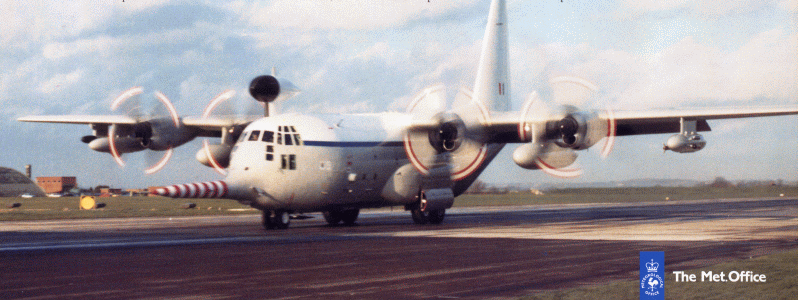
On 13th September a team from Imperial College flew a new revolutionary experiment on board the Met-office research aircraft, the Tropospheric Airborne Fourier Transform Spectrometer, TAFTS. This unique instrument has been conceived, designed and built by the Atmospheric Physics group at Imperial College to measure the radiative effects of water vapour and ice clouds on the Earth's energy balance. The picture above shows the Met-office C130 research aircraft, TAFTS is in the port maxipod, furthest out from the aircraft.
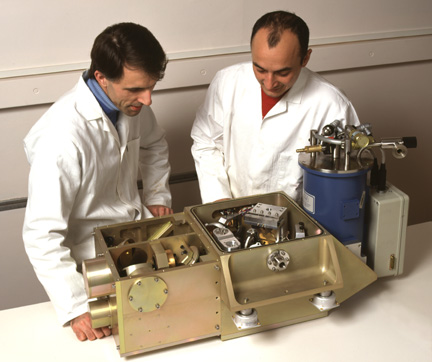 The project was initially instigated by Prof. John Harries and taken to completion by the science team of two, Tony Cañas and Jon Murray, pictured right with the TAFTS instrument, plus alot of hard work from the department workshops and new recruit Paul Green.
The project was initially instigated by Prof. John Harries and taken to completion by the science team of two, Tony Cañas and Jon Murray, pictured right with the TAFTS instrument, plus alot of hard work from the department workshops and new recruit Paul Green.
The instrument is a first, measuring the difference in radiance coming from the up-welling and down-welling energy of the atmosphere in the very far infrared, 20 - 120 µm, at high spectral resolution. This region has recently been recognised as playing a major role in global warming but has proved very difficult to observe, until the development of TAFTS.
The September flight was designed as an engineering "shakedown flight" for the instrument before scientific flights start at the end of November, the Met-office MOTH-Arctic campaign. The team is very pleased with the results of this first flight which has generated never before seen data on the Earth's radiation balance which, in turn, will lead to a better understanding of the greenhouse effect. The details of this first flight will be published shortly, in the mean time work goes on to prepare for the Arctic campaign.
Thanks go to Peter Ade and his group at Queen Mary Westfield College for their advice and contribution of essential optical components. TAFTS was funded by the NERC on the IFMA II initiative.
Jon Murray 13th October 1999
View August's news, older news or return to Space and Atmospheric Physics home page